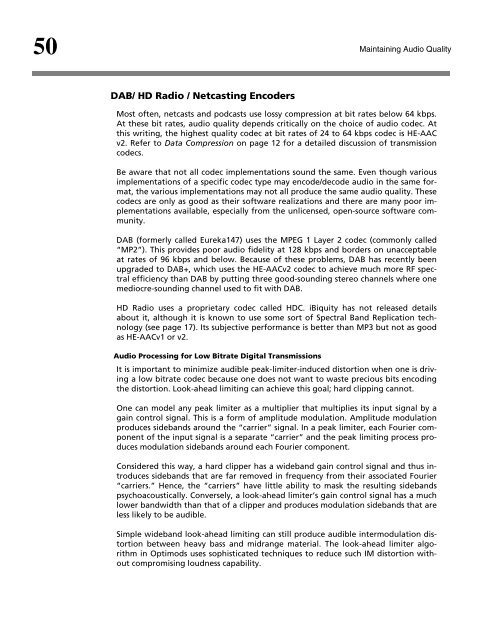Maintaining Audio Quality in the Broadcast Facility 2011 - Orban
Maintaining Audio Quality in the Broadcast Facility 2011 - Orban
Maintaining Audio Quality in the Broadcast Facility 2011 - Orban
You also want an ePaper? Increase the reach of your titles
YUMPU automatically turns print PDFs into web optimized ePapers that Google loves.
50<br />
DAB/ HD Radio / Netcast<strong>in</strong>g Encoders<br />
<strong>Ma<strong>in</strong>ta<strong>in</strong><strong>in</strong>g</strong> <strong>Audio</strong> <strong>Quality</strong><br />
Most often, netcasts and podcasts use lossy compression at bit rates below 64 kbps.<br />
At <strong>the</strong>se bit rates, audio quality depends critically on <strong>the</strong> choice of audio codec. At<br />
this writ<strong>in</strong>g, <strong>the</strong> highest quality codec at bit rates of 24 to 64 kbps codec is HE-AAC<br />
v2. Refer to Data Compression on page 12 for a detailed discussion of transmission<br />
codecs.<br />
Be aware that not all codec implementations sound <strong>the</strong> same. Even though various<br />
implementations of a specific codec type may encode/decode audio <strong>in</strong> <strong>the</strong> same format,<br />
<strong>the</strong> various implementations may not all produce <strong>the</strong> same audio quality. These<br />
codecs are only as good as <strong>the</strong>ir software realizations and <strong>the</strong>re are many poor implementations<br />
available, especially from <strong>the</strong> unlicensed, open-source software community.<br />
DAB (formerly called Eureka147) uses <strong>the</strong> MPEG 1 Layer 2 codec (commonly called<br />
“MP2”). This provides poor audio fidelity at 128 kbps and borders on unacceptable<br />
at rates of 96 kbps and below. Because of <strong>the</strong>se problems, DAB has recently been<br />
upgraded to DAB+, which uses <strong>the</strong> HE-AACv2 codec to achieve much more RF spectral<br />
efficiency than DAB by putt<strong>in</strong>g three good-sound<strong>in</strong>g stereo channels where one<br />
mediocre-sound<strong>in</strong>g channel used to fit with DAB.<br />
HD Radio uses a proprietary codec called HDC. iBiquity has not released details<br />
about it, although it is known to use some sort of Spectral Band Replication technology<br />
(see page 17). Its subjective performance is better than MP3 but not as good<br />
as HE-AACv1 or v2.<br />
<strong>Audio</strong> Process<strong>in</strong>g for Low Bitrate Digital Transmissions<br />
It is important to m<strong>in</strong>imize audible peak-limiter-<strong>in</strong>duced distortion when one is driv<strong>in</strong>g<br />
a low bitrate codec because one does not want to waste precious bits encod<strong>in</strong>g<br />
<strong>the</strong> distortion. Look-ahead limit<strong>in</strong>g can achieve this goal; hard clipp<strong>in</strong>g cannot.<br />
One can model any peak limiter as a multiplier that multiplies its <strong>in</strong>put signal by a<br />
ga<strong>in</strong> control signal. This is a form of amplitude modulation. Amplitude modulation<br />
produces sidebands around <strong>the</strong> “carrier” signal. In a peak limiter, each Fourier component<br />
of <strong>the</strong> <strong>in</strong>put signal is a separate “carrier” and <strong>the</strong> peak limit<strong>in</strong>g process produces<br />
modulation sidebands around each Fourier component.<br />
Considered this way, a hard clipper has a wideband ga<strong>in</strong> control signal and thus <strong>in</strong>troduces<br />
sidebands that are far removed <strong>in</strong> frequency from <strong>the</strong>ir associated Fourier<br />
“carriers.” Hence, <strong>the</strong> “carriers” have little ability to mask <strong>the</strong> result<strong>in</strong>g sidebands<br />
psychoacoustically. Conversely, a look-ahead limiter’s ga<strong>in</strong> control signal has a much<br />
lower bandwidth than that of a clipper and produces modulation sidebands that are<br />
less likely to be audible.<br />
Simple wideband look-ahead limit<strong>in</strong>g can still produce audible <strong>in</strong>termodulation distortion<br />
between heavy bass and midrange material. The look-ahead limiter algorithm<br />
<strong>in</strong> Optimods uses sophisticated techniques to reduce such IM distortion without<br />
compromis<strong>in</strong>g loudness capability.



![[PDF] Using the ITU BS.1770-2 and CBS Loudness Meters ... - Orban](https://img.yumpu.com/50629372/1/190x245/pdf-using-the-itu-bs1770-2-and-cbs-loudness-meters-orban.jpg?quality=85)






![[PDF] Optimod-FM Feature Comparison - Orban](https://img.yumpu.com/41741615/1/190x245/pdf-optimod-fm-feature-comparison-orban.jpg?quality=85)






